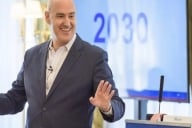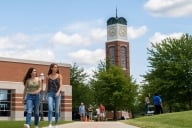You have /5 articles left.
Sign up for a free account or log in.

Students in an advanced manufacturing program at Houston Community College
Houston Community College
As part of its pitch for expanding apprenticeship opportunities, a White House-convened task force last week released a report that took several shots at colleges and universities.
“The American higher education system is churning out a pool of in-debt job seekers who are not equipped to meet the skills needs of many employers in the modern American economy,” the report said.
The strongly worded criticism was notable in part because the 20-member task force included two higher education representatives: Walter Bumphus, president and CEO of the American Association of Community Colleges, and Mark B. Rosenberg, president of Florida International University and a board member for the Association of Public and Land-grant Universities.
In a written statement, Bumphus said he was given little time to review the report and that he focused on its recommendations. Rosenberg said in an interview that he pushed back on the task force's higher ed bashing, but that he wanted to make sure that universities were represented on the panel.
“I’m uncomfortable with the report’s characterizations of student debt … I stated that. I’m on the record,” said Rosenberg. But he added that “I didn’t think we should be shut out of the game.”
For the most part, the federal panel echoed the Trump administration’s oft-cited argument that vocational education is underemphasized relative to college degree programs. That’s not surprising, given that the group was led by several members of Trump's cabinet -- it was chaired by the U.S. secretaries of education, labor and commerce and included Ivanka Trump.
But the task force’s language about higher education went farther than Betsy DeVos, the education secretary, did in a letter that accompanied the report. DeVos wrote that a “traditional college education and a modern-day apprenticeship are no longer mutually exclusive education options.”
The report, however, said higher education “is a narrow path that is not working for enough young people, in part because it is becoming increasingly unaffordable and no longer guarantees a middle-class income.”
Apprenticeships are important, said Karen Stout, president and CEO of Achieving the Dream, a nonprofit group focused on student completion at community colleges. Stout said she supports the task force’s work, but she questioned why the report criticized other forms of postsecondary job training.
“The work that we’re doing with traditional credentials is also important,” said Stout, a former community college president. “I don’t think the rhetoric should look past the fact that traditional higher education is still highly valued by employers.”
Debt and the Skills Gap
The task force called out four-year degree programs in particular, saying they “have become increasingly unaffordable for the average American, culminating in the current student loan crisis.”
The report cited data on the total amount of U.S. student loan debt (more than $1.3 trillion) and the average amount held by college graduates in 2016, which it listed as $37,000. While that number may or may not be right -- several recent news accounts attribute that figure to preliminary data from Mark Kantrowitz, a well-regarded expert on financial aid -- only about seven in 10 college students take out any loans at all, so listing the figure as the average amount held by all graduates is incorrect.
The report also included an apparently inaccurate dig about the number of graduates in technology fields that American colleges produce each year.
The traditional four-year education model “often is disconnected from business needs and not suited for providing workers the combination of skills and practical work experience that employers value,” the report said. “Today, there are over 500,000 technology jobs open, but U.S. colleges and universities produce only 50,000 graduates each year, creating a shortfall in skilled candidates across economic sectors.”
More than one-third of bachelor’s degrees awarded annually are in science and engineering -- with 589,330 earned in 2012, according to the National Science Foundation. (Another 161,371 students earned master’s degrees in science and engineering that year, with 35,360 earning doctoral degrees.)
Rosenberg, who was listed on the report in his capacity as a board member for the land-grant university association, said APLU focuses on student access, graduation and employment. And he said there’s plenty of work to do in those areas.
“There’s a recognition in this country that debt levels are high, and perhaps out of control,” he said, adding that higher education also needs to do a better job of teaching undergraduates critical thinking and preparing them for the work force.
Rosenberg cautioned against college leaders being too sensitive about the report’s findings, noting that it also pushes for more involvement by employers.
“It’s only the first step,” he said of the task force report. “Everybody at that table is grappling with how to get a better hold on work-force training.”
While community college colleges caught less heat than four-year colleges in the report, they were not spared.
For example, the task force cited a review of Washington State’s work-force training outcomes, which “found apprenticeships boosted participants’ future taxable incomes and thus yielded a $23 return to taxpayers for every public dollar spent, compared with a $3 return for community college.”
Bumphus said the report’s criticisms of higher education “do not capture the tone and tenor of the meetings” or of the task force itself. “In fact, community colleges in particular were often touted by various members of the task force as a critical pathway toward closing the skills gap in America.”
As a participant, Bumphus said, he was able to showcase the nation’s 1,103 community colleges while continuing valuable partnerships with industry and government to expand programs to serve more students and create stronger employment pipelines.
“Further, it allowed AACC to speak directly to the administration and to President Trump about the value of the community college and clarify its multiple roles in both traditional and vocational postsecondary education,” he said.
For his part, Rosenberg said, the task force was right to push for higher education and employers to be “more progressive about learning and earning opportunities.”
And while the broader context of the report and its findings are open to interpretation, Rosenberg said he met his objectives for public universities by participating in the task force. “I wanted to make sure we weren’t excluded.”








